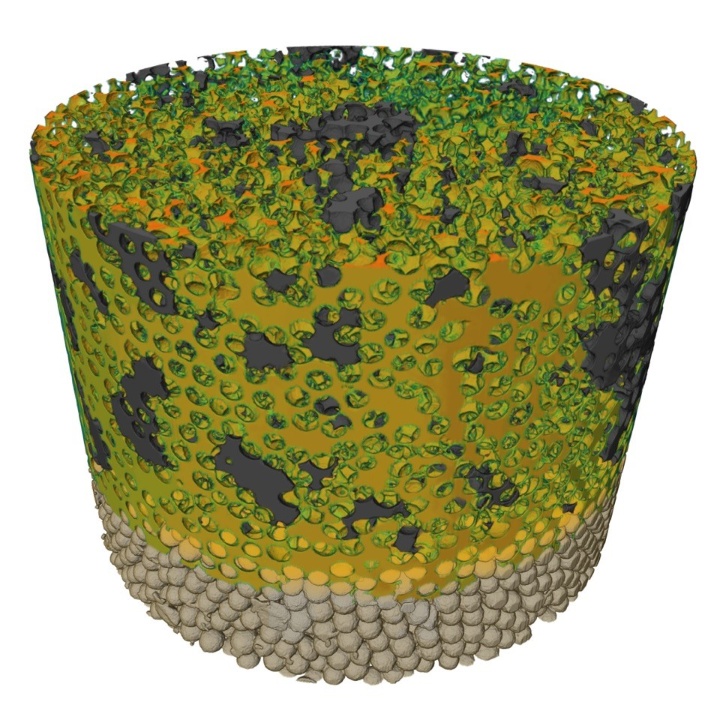How pollutants spread in so-called partially saturated porous media - for example in sand or gravel - is difficult to compute due to the complex processes involved. A team led by Holger Steeb, Head of Research in the SimTech Cluster of Excellence as well as in the Collaborative Research Center 1313 of the University of Stuttgart, has now been able to visualize solute transport in the pore space using high-resolution synchrotron-based X-ray tomography. The renowned scientific journal PNAS reported on this*.
Transport processes in porous media play an extremely important role in a variety of technical applications. Either a single fluid (liquids or gases) can flow through the pores in a solid body - in this case, we speak of fully saturated porous media - or a phase mixture such as gas/oil and water. The latter, so-called partially saturated porous media, occur very often in practice, for example in near-surface sand and gravel soils, in gas and oil deposits, and in geothermal reservoirs. If now - for example due to an environmental disaster - contaminants get into the subsoil, it is relatively easy to compute how they spread in fully saturated porous media. Regarding partially saturated porous media, however, the convective (by flow) and diffusive (by mixing) propagation processes were not clear until now.
Using imaging techniques, the team of Prof. Holger Steeb at the University of Stuttgart has now been able to prove for the first time that solute transport in partially saturated porous media is fundamentally different from that in fully saturated porous media. For this purpose, the researchers flushed salted water into an oil-water mixture and made the complex transport process in the pore space visible, using synchrotron-based X-ray tomography in four-dimensional investigations with high spatial and temporal resolution.
Better prediction models as a goal
It was found that stagnant, i.e. non-moving, sections in the pore space of the porous material play an important role in the dispersion of the salt water particles. While in the moving zones the transport process is dominated by convection, in the stagnant zones it is mainly diffusion processes that determine the time scale in which the salt water particles are spreading.
Based on the high-resolution 4D data sets (3.25 microns in space and 6 seconds in time), both the moving and the stagnant zones could be precisely characterized, and their fluid-topological impact (“footprint”) on the effective non-Fick diffusion (a model for the calculation of diffusion processes) could be shown. On the basis of these results, effective simulation models on the so-called Darcy scale can be further developed in the future on a physical basis. This, the researchers hope, will lead to improved forecasting models with which, for example, the effects on soil or drinking water in the event of pollutant contamination can be predicted more accurately.
The work was developed within the Collaborative Research Center (SFB) 1313 and the Cluster of Excellence (EXC) 2075 (SimTech) at the University of Stuttgart, in close cooperation with colleagues at the University of Manchester, UK, the Helmholtz Center in Dresden-Rossendorf, and Diamond Lightsource in Didcot, UK.
Expert Contact:
Holger Steeb, University of Stuttgart, Institute of Applied Mechanics (Civil Engineering) / Chair II (Continuum Mechanics), phone: +49 711 685-66346, email
*Original publication:
“Direct characterization of solute transport in unsaturated porous media using fast X-ray synchrotron microtomography”, S. Hasan, V. Niasar, N.K. Karadimitriou, J.R.A. Godinho, N.T. Vo, S. An, A. Rabbania and H. Steeb, PNAS from 8 September 2020,
https://www.pnas.org/content/early/2020/09/03/2011716117



